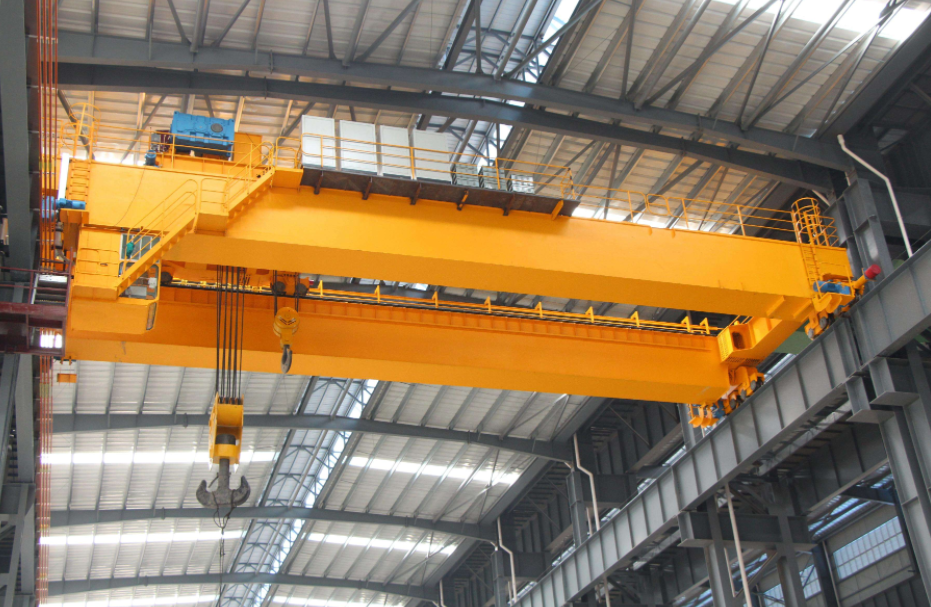The Impact of Double Girder Overhead Crane Design on Safety
- blog@ellsenbridgecrane.com
- Aug 2, 2024
- 4 min read
Double girder overhead cranes are essential equipment in many industrial settings, including manufacturing, construction, and heavy lifting applications. Their design plays a pivotal role in ensuring both operational efficiency and safety. In this article, we will explore how the design features of double girder overhead cranes contribute to safety, examine key safety considerations, and discuss best practices for maintaining safety in operations.

Understanding Double Girder Overhead Cranes
A double girder overhead crane is characterized by its two parallel beams or girders that support the bridge of the crane. This design allows for a robust and stable structure capable of handling heavier loads compared to single girder cranes. The two-girder system provides enhanced rigidity and strength, making it suitable for demanding industrial environments.
Design Features Contributing to Safety
Enhanced Load Distribution: One of the primary safety advantages of a double girder design is its ability to distribute loads more evenly across the crane structure. The two girders work in tandem to support the bridge, which helps in managing the stresses and strains imposed by heavy loads. This even distribution reduces the risk of structural failure and extends the lifespan of the crane.
Increased Load Capacity: Double girder overhead cranes are designed to handle larger and heavier loads than their single girder counterparts. The increased load capacity means that the crane can operate safely within its designed limits, minimizing the risk of overloading. Proper load capacity ensures that the crane performs efficiently without compromising safety.
Improved Stability and Rigidity: The double girder configuration offers greater stability and rigidity, which is crucial for safe operations. The additional girder provides extra support and reduces the risk of the crane swaying or tilting, especially when handling uneven or off-center loads. This stability helps in maintaining control and accuracy during lifting operations.
Advanced Safety Features: Modern industrial overhead cranes are equipped with advanced safety features, including:
Limit Switches: These prevent the crane from moving beyond its safe operating range, reducing the risk of accidents.
Overload Protection: Sensors and alarms are installed to alert operators if the crane is approaching or exceeding its load limit.
Anti-Sway Mechanisms: These systems help in reducing load swaying, which can prevent accidents and improve load handling accuracy.
Enhanced Visibility and Control: The design of double girder cranes often includes improved visibility for operators. The crane's height and the positioning of the hoist and trolley allow operators to have a clear view of the load and the surrounding area. Additionally, advanced control systems, including remote controls and automated features, provide operators with precise control over crane movements, contributing to safer operations.
Key Safety Considerations
Regular Maintenance and Inspections - Regular maintenance and inspections are critical for ensuring the ongoing safety of double girder overhead cranes. Routine checks should include inspections of the structural integrity, load-bearing components, and safety features. Maintenance schedules should be followed meticulously to address any wear and tear or potential issues before they compromise safety.
Operator Training and Competence - Proper training for crane operators is essential for safe operation. Operators should be familiar with the crane's design, load capacities, and safety features. Training should cover not only the operational aspects but also emergency procedures and safe practices for handling different types of loads.
Safe Load Handling Practices - Implementing safe load handling practices is vital for preventing accidents. This includes ensuring that loads are properly secured, using appropriate lifting techniques, and avoiding sudden movements that could destabilize the crane. Operators should also be aware of the crane's load chart and adhere to its limits.
Environmental Considerations - The operating environment can impact crane safety. Factors such as temperature extremes, humidity, and exposure to corrosive substances can affect the crane's performance and structural integrity. It is important to assess environmental conditions and implement measures to protect the crane from adverse effects.
Best Practices for Ensuring Safety
Adherence to Safety Standards - Following industry safety standards and regulations is crucial for maintaining safety in crane operations. Compliance with standards such as those set by the Occupational Safety and Health Administration (OSHA) or the International Organization for Standardization (ISO) ensures that safety practices are up-to-date and effective.
Use of High-Quality Components - The safety of a double girder overhead crane is greatly influenced by the quality of its components. Using high-quality materials and components from reputable manufacturers ensures that the crane performs reliably and safely. Investing in quality components can prevent malfunctions and extend the crane's operational life.
Implementation of Safety Procedures - Developing and implementing comprehensive safety procedures is essential for safe crane operations. This includes establishing protocols for routine inspections, emergency response, and load handling. Procedures should be communicated clearly to all personnel involved in crane operations.
Regular Safety Audits - Conducting regular safety audits helps in identifying potential risks and areas for improvement. Safety audits should be thorough and cover all aspects of crane operations, including equipment, procedures, and training. Addressing any identified issues promptly can prevent accidents and enhance overall safety.
Conclusion
The design of double girder overhead cranes has a significant impact on safety, thanks to its robust load distribution, increased capacity, and enhanced stability. However, ensuring safety goes beyond design; it requires regular maintenance, operator training, adherence to safety standards, and implementation of best practices. By focusing on these aspects, industries can maximize the safety and efficiency of their crane operations, minimizing risks and enhancing overall workplace safety.








Comments